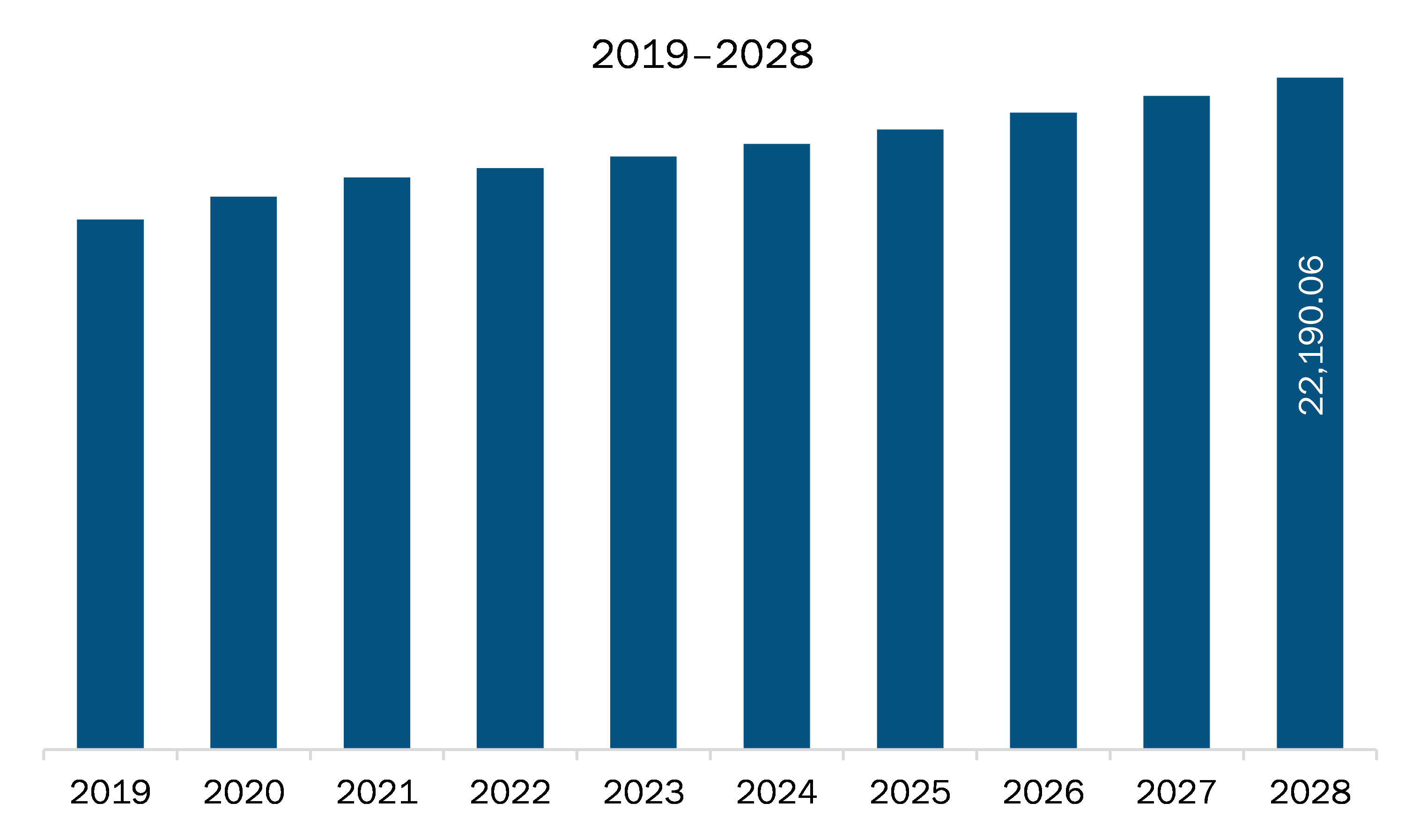The North America polyurethane market is expected to grow from US$ 13,150.40 million in 2021 to US$ 22,190.06 million by 2028; it is estimated to grow at a CAGR of 7.8% from 2021 to 2028.
Polyurethane is a thermosetting polymer which is composed of organic units joined by carbamate links and does not melt on heating. It is light in weight, resistant to corrosion, elastic in nature and possesses considerable strength. In most of the cases, polyurethane is an alternative to paper, glass, and metals. High mechanical strength enables polyurethane to provide insulation and replace metals for automobile parts. The polyurethane market is anticipated to grow in the forecast period owing to an upsurge in demand for lightweight and durable materials from automotive, packaging, furniture, footwear, and other end-user industries. Moreover, demands for high-performance interior components further contributes to the polyurethane market growth. However, fluctuations in raw materials and economic downturn in developing countries affect products sales which hinder growth of the polyurethane market. On the other hand, adoption of bio-based polyurethane is likely to provide growth opportunities to the key players operating in the polyurethane market during the forecast period.
In case of COVID-19, in North America, especially the US, witnessed an unprecedented rise in number of coronavirus cases, which led to the discontinuation of polyurethane manufacturing activities. Downfall of other chemical and materials manufacturing sectors has negatively impacted the demand for polyurethane during the early months of 2020. Moreover, decline in the overall resin and polymer manufacturing activities has led to discontinuation of polyurethane manufacturing projects, thereby reducing the demand for polyurethane. Similar trend was witnessed in other North America countries, i.e., Mexico, Canada, Panama and Costa Rica. However, the countries are likely to overcome thus drop in demand with the economic activities regaining their pace, especially in the beginning of the 2021.

- Sample PDF showcases the content structure and the nature of the information with qualitative and quantitative analysis.
- Request discounts available for Start-Ups & Universities
North America Polyurethane Market Segmentation
North America Polyurethane Market – By Product
- Rigid Foam
- Flexible Foam
- Coatings Adhesives and Sealants
- Elastomers
- Others
North America Polyurethane Market – By Application
- Furniture and Interiors
- Construction
- Electronics and Appliances
- Automotive
- Footwear
- Packaging
- Others
North America Polyurethane Market – By Country
- US
- Canada
- Mexico

Report Coverage
Revenue forecast, Company Analysis, Industry landscape, Growth factors, and Trends

Segment Covered
Product and Application

Regional Scope
North America, Europe, Asia Pacific, Middle East & Africa, South & Central America

Country Scope
US, Canada
1. Introduction
1.1 Study Scope
1.2 The Insight Partners Research Report Guidance
1.3 Market Segmentation
2. Key Takeaways
3. Research Methodology
3.1 Scope of the Study
3.2 Research Methodology
3.2.1 Data Collection:
3.2.2 Primary Interviews:
3.2.3 Hypothesis formulation:
3.2.4 Macro-economic factor analysis:
3.2.5 Developing base number:
3.2.6 Data Triangulation:
3.2.7 Country level data:
4. North America Polyurethane Market Landscape
4.1 Market Overview
4.2 PEST Analysis
4.3 Expert Opinion
5. North America Polyurethane Market– Key Market Dynamics
5.1 Market Drivers
5.1.1 Rising Demand for Durable and Lightweight Materials from Several End -Use Industries
5.2 Market Restraints
5.2.1 Imposition of Strict Regulations on Raw Material Used in Polyurethane Manufacturing
5.2.2 Volatility of Raw Material Prices
5.3 Market Opportunities
5.3.1 Increased Support by Governments for Infrastructure Development and Rising Use of PU as Insulation Material
5.4 Future Trends
5.4.1 Growing Demand for Low VOC, Green, and Sustainable Polyurethane
5.5 Impact Analysis
6. Polyurethane – North America Market Analysis
6.1 Polyurethane Market Overview
6.2 Polyurethane Market – Revenue Forecasts to 2028 (US$ Million)
7. North America Polyurethane Market Analysis – By Product
7.1 Overview
7.2 Polyurethane Market, By Product (2020 and 2028)
7.3 Rigid Foam
7.3.1 Overview
7.3.2 Rigid Foam: Polyurethane Market – Revenue and Forecast to 2028 (US$ Mn)
7.4 Flexible Foam
7.4.1 Overview
7.4.2 Flexible Foam: Polyurethane Market – Revenue and Forecast to 2028 (US$ Mn)
7.5 Coating, Adhesives, and Sealants
7.5.1 Overview
7.5.2 Coating, Adhesives, and Sealants: Polyurethane Market – Revenue and Forecast to 2028 (US$ Mn)
7.6 Elastomers
7.6.1 Overview
7.6.2 Elastomers: Polyurethane Market – Revenue and Forecast to 2028 (US$ Mn)
7.7 Others
7.7.1 Overview
7.7.2 Others: Polyurethane Market – Revenue and Forecast to 2028 (US$ Mn)
8. North America Polyurethane Market Analysis – By Application
8.1 Overview
8.2 Polyurethane Market, By Application (2020 and 2028)
8.3 Furniture and Interiors
8.3.1 Overview
8.3.2 Furniture and Interiors: Polyurethane Market – Revenue and Forecast to 2028 (US$ Mn)
8.4 Construction
8.4.1 Overview
8.4.2 Construction: Polyurethane Market – Revenue and Forecast to 2028 (US$ Mn)
8.5 Electronics and Appliances
8.5.1 Overview
8.5.2 Electronics and Appliances: Polyurethane Market – Revenue and Forecast to 2028 (US$ Mn)
8.6 Automotive
8.6.1 Overview
8.6.2 Automotive: Polyurethane Market – Revenue and Forecast to 2028 (US$ Mn)
8.7 Footwear
8.7.1 Overview
8.7.2 Footwear: Polyurethane Market – Revenue and Forecast to 2028 (US$ Mn)
8.8 Packaging
8.8.1 Overview
8.8.2 Packaging: Polyurethane Market – Revenue and Forecast to 2028 (US$ Mn)
8.9 Others
8.9.1 Overview
8.9.2 Others: Polyurethane Market – Revenue and Forecast to 2028 (US$ Mn)
9. North America Polyurethane Market – Country Analysis
9.1 North America: Polyurethane Market
9.1.1 North America: Polyurethane Market, by Key Country
9.1.1.1 US: Polyurethane Market –Revenue and Forecast to 2028 (US$ Million)
9.1.1.1.1 US: Polyurethane Market, Product
9.1.1.1.2 US: Polyurethane Market, Application
9.1.1.2 Canada: Polyurethane Market –Revenue and Forecast to 2028 (US$ Million)
9.1.1.2.1 Canada: Polyurethane Market, Product
9.1.1.2.2 Canada: Polyurethane Market, Application
9.1.1.3 Mexico: Polyurethane Market –Revenue and Forecast to 2028 (US$ Million)
9.1.1.3.1 Mexico: Polyurethane Market, Product
9.1.1.3.2 Mexico: Polyurethane Market, Application
10. Impact COVID-19 Pandemic on North America Polyurethane Market
10.1 Impact of COVID-19 on Polyurethane Market
10.2 North America: Impact Assessment of COVID-19 Pandemic
11. Industry Landscape
11.1 Overview
11.2 Mergers & acquisition
11.3 Company News
12. Company Profiles
12.1 Covestro AG
12.1.1 Key Facts
12.1.2 Business Description
12.1.3 Products and Services
12.1.4 Financial Overview
12.1.5 SWOT Analysis
12.1.6 Key Developments
12.2 FXI
12.2.1 Key Facts
12.2.2 Business Description
12.2.3 Products and Services
12.2.4 Financial Overview
12.2.5 SWOT Analysis
12.2.6 Key Developments
12.3 Huntsman Corporation
12.3.1 Key Facts
12.3.2 Business Description
12.3.3 Products and Services
12.3.4 Financial Overview
12.3.5 SWOT Analysis
12.3.6 Key Developments
12.4 Lubrizol Corporation
12.4.1 Key Facts
12.4.2 Business Description
12.4.3 Products and Services
12.4.4 Financial Overview
12.4.5 SWOT Analysis
12.4.6 Key Developments
12.5 Mitsui Chemicals, Inc.
12.5.1 Key Facts
12.5.2 Business Description
12.5.3 Products and Services
12.5.4 Financial Overview
12.5.5 SWOT Analysis
12.5.6 Key Developments
12.6 BASF SE
12.6.1 Key Facts
12.6.2 Business Description
12.6.3 Products and Services
12.6.4 Financial Overview
12.6.5 SWOT Analysis
12.6.6 Key Developments
12.7 The Dow Chemical Company
12.7.1 Key Facts
12.7.2 Business Description
12.7.3 Products and Services
12.7.4 Financial Overview
12.7.5 SWOT Analysis
12.7.6 Key Developments
12.8 DIC Corporation
12.8.1 Key Facts
12.8.2 Business Description
12.8.3 Products and Services
12.8.4 Financial Overview
12.8.5 SWOT Analysis
12.8.6 Key Developments
12.9 Recticel NV
12.9.1 Key Facts
12.9.2 Business Description
12.9.3 Products and Services
12.9.4 Financial Overview
12.9.5 SWOT Analysis
12.9.6 Key Developments
12.10 Tosoh Corporation
12.10.1 Key Facts
12.10.2 Business Description
12.10.3 Products and Services
12.10.4 Financial Overview
12.10.5 SWOT Analysis
12.10.6 Key Developments
13. Appendix
13.1 About The Insight Partners
13.2 Glossary of Terms
LIST OF TABLES
Table 1. North America Polyurethane Market –Revenue Forecast to 2028 (US$ Million)
Table 2. US Polyurethane Market, Product – Revenue and Forecast to 2028 (US$ Million)
Table 3. US Polyurethane Market, Application – Revenue and Forecast to 2028 (US$ Million)
Table 4. Canada Polyurethane Market, Product– Revenue and Forecast to 2028 (US$ Million)
Table 5. Canada Polyurethane Market, Application– Revenue and Forecast to 2028 (US$ Million)
Table 6. Mexico Polyurethane Market, Product – Revenue and Forecast to 2028 (US$ Million)
Table 7. Mexico Polyurethane Market, Application – Revenue and Forecast to 2028 (US$ Million)
Table 8. Glossary of Terms, Polyurethane Market
LIST OF FIGURES
Figure 1. Polyurethane Market Segmentation
Figure 2. North America Polyurethane Market Segmentation – By Country
Figure 3. North America Polyurethane Market Overview
Figure 4. Flexible Foam Segment Held Largest Share of North America Polyurethane Market
Figure 5. US Held Largest Share of North America Polyurethane Market
Figure 6. North America Polyurethane Market, Key Market Players
Figure 7. North America PEST Analysis
Figure 8. Expert Opinion
Figure 9. Impact Analysis of Drivers and Restraints
Figure 10. North America: Polyurethane Market – Revenue Forecast to 2028 (US$ Million)
Figure 11. Polyurethane Market Revenue Share, By Product (2020 and 2028)
Figure 12. Rigid Foam: Polyurethane Market – Revenue and Forecast to 2028 (US$ Mn)
Figure 13. Flexible Foam: Polyurethane Market – Revenue and Forecast to 2028 (US$ Mn)
Figure 14. Coating, Adhesives, and Sealants: Polyurethane Market – Revenue and Forecast to 2028 (US$ Mn)
Figure 15. Elastomers: Polyurethane Market – Revenue and Forecast to 2028 (US$ Mn)
Figure 16. Others: Polyurethane Market – Revenue and Forecast to 2028 (US$ Mn)
Figure 17. Polyurethane Market Revenue Share, By Application (2020 and 2028)
Figure 18. Furniture and Interiors: Polyurethane Market – Revenue and Forecast to 2028 (US$ Mn)
Figure 19. Construction: Polyurethane Market – Revenue and Forecast to 2028 (US$ Mn)
Figure 20. Electronics and Appliances: Polyurethane Market – Revenue and Forecast to 2028 (US$ Mn)
Figure 21. Automotive: Polyurethane Market – Revenue and Forecast to 2028 (US$ Mn)
Figure 22. Footwear: Polyurethane Market – Revenue and Forecast to 2028 (US$ Mn)
Figure 23. Packaging: Polyurethane Market – Revenue and Forecast to 2028 (US$ Mn)
Figure 24. Others: Polyurethane Market – Revenue and Forecast to 2028 (US$ Mn)
Figure 25. North America: Polyurethane Market, by Key Country – Revenue (2020) (USD Million)
Figure 26. North America: Polyurethane Market Revenue Share, by Key Country (2020 and 2028)
Figure 27. US: Polyurethane Market –Revenue and Forecast to 2028 (US$ Million)
Figure 28. Canada: Polyurethane Market –Revenue and Forecast to 2028 (US$ Million)
Figure 29. Mexico: Polyurethane Market –Revenue and Forecast to 2028 (US$ Million)
Figure 30. Impact of COVID-19 Pandemic in North American Country Markets
- Covestro AG
- FXI
- Huntsman Corporation
- Lubrizol Corporation
- Mitsui Chemicals, Inc.
- BASF SE
- The Dow Chemical Company
- DIC Corporation
- Recticel NV
- Tosoh Corporation
The Insight Partners performs research in 4 major stages: Data Collection & Secondary Research, Primary Research, Data Analysis and Data Triangulation & Final Review.
- Data Collection and Secondary Research:
As a market research and consulting firm operating from a decade, we have published many reports and advised several clients across the globe. First step for any study will start with an assessment of currently available data and insights from existing reports. Further, historical and current market information is collected from Investor Presentations, Annual Reports, SEC Filings, etc., and other information related to company’s performance and market positioning are gathered from Paid Databases (Factiva, Hoovers, and Reuters) and various other publications available in public domain.
Several associations trade associates, technical forums, institutes, societies and organizations are accessed to gain technical as well as market related insights through their publications such as research papers, blogs and press releases related to the studies are referred to get cues about the market. Further, white papers, journals, magazines, and other news articles published in the last 3 years are scrutinized and analyzed to understand the current market trends.
- Primary Research:
The primarily interview analysis comprise of data obtained from industry participants interview and answers to survey questions gathered by in-house primary team.
For primary research, interviews are conducted with industry experts/CEOs/Marketing Managers/Sales Managers/VPs/Subject Matter Experts from both demand and supply side to get a 360-degree view of the market. The primary team conducts several interviews based on the complexity of the markets to understand the various market trends and dynamics which makes research more credible and precise.
A typical research interview fulfils the following functions:
- Provides first-hand information on the market size, market trends, growth trends, competitive landscape, and outlook
- Validates and strengthens in-house secondary research findings
- Develops the analysis team’s expertise and market understanding
Primary research involves email interactions and telephone interviews for each market, category, segment, and sub-segment across geographies. The participants who typically take part in such a process include, but are not limited to:
- Industry participants: VPs, business development managers, market intelligence managers and national sales managers
- Outside experts: Valuation experts, research analysts and key opinion leaders specializing in the electronics and semiconductor industry.
Below is the breakup of our primary respondents by company, designation, and region:

Once we receive the confirmation from primary research sources or primary respondents, we finalize the base year market estimation and forecast the data as per the macroeconomic and microeconomic factors assessed during data collection.
- Data Analysis:
Once data is validated through both secondary as well as primary respondents, we finalize the market estimations by hypothesis formulation and factor analysis at regional and country level.
- 3.1 Macro-Economic Factor Analysis:
We analyse macroeconomic indicators such the gross domestic product (GDP), increase in the demand for goods and services across industries, technological advancement, regional economic growth, governmental policies, the influence of COVID-19, PEST analysis, and other aspects. This analysis aids in setting benchmarks for various nations/regions and approximating market splits. Additionally, the general trend of the aforementioned components aid in determining the market's development possibilities.
- 3.2 Country Level Data:
Various factors that are especially aligned to the country are taken into account to determine the market size for a certain area and country, including the presence of vendors, such as headquarters and offices, the country's GDP, demand patterns, and industry growth. To comprehend the market dynamics for the nation, a number of growth variables, inhibitors, application areas, and current market trends are researched. The aforementioned elements aid in determining the country's overall market's growth potential.
- 3.3 Company Profile:
The “Table of Contents” is formulated by listing and analyzing more than 25 - 30 companies operating in the market ecosystem across geographies. However, we profile only 10 companies as a standard practice in our syndicate reports. These 10 companies comprise leading, emerging, and regional players. Nonetheless, our analysis is not restricted to the 10 listed companies, we also analyze other companies present in the market to develop a holistic view and understand the prevailing trends. The “Company Profiles” section in the report covers key facts, business description, products & services, financial information, SWOT analysis, and key developments. The financial information presented is extracted from the annual reports and official documents of the publicly listed companies. Upon collecting the information for the sections of respective companies, we verify them via various primary sources and then compile the data in respective company profiles. The company level information helps us in deriving the base number as well as in forecasting the market size.
- 3.4 Developing Base Number:
Aggregation of sales statistics (2020-2022) and macro-economic factor, and other secondary and primary research insights are utilized to arrive at base number and related market shares for 2022. The data gaps are identified in this step and relevant market data is analyzed, collected from paid primary interviews or databases. On finalizing the base year market size, forecasts are developed on the basis of macro-economic, industry and market growth factors and company level analysis.
- Data Triangulation and Final Review:
The market findings and base year market size calculations are validated from supply as well as demand side. Demand side validations are based on macro-economic factor analysis and benchmarks for respective regions and countries. In case of supply side validations, revenues of major companies are estimated (in case not available) based on industry benchmark, approximate number of employees, product portfolio, and primary interviews revenues are gathered. Further revenue from target product/service segment is assessed to avoid overshooting of market statistics. In case of heavy deviations between supply and demand side values, all thes steps are repeated to achieve synchronization.
We follow an iterative model, wherein we share our research findings with Subject Matter Experts (SME’s) and Key Opinion Leaders (KOLs) until consensus view of the market is not formulated – this model negates any drastic deviation in the opinions of experts. Only validated and universally acceptable research findings are quoted in our reports.
We have important check points that we use to validate our research findings – which we call – data triangulation, where we validate the information, we generate from secondary sources with primary interviews and then we re-validate with our internal data bases and Subject matter experts. This comprehensive model enables us to deliver high quality, reliable data in shortest possible time.


 Get Free Sample For
Get Free Sample For